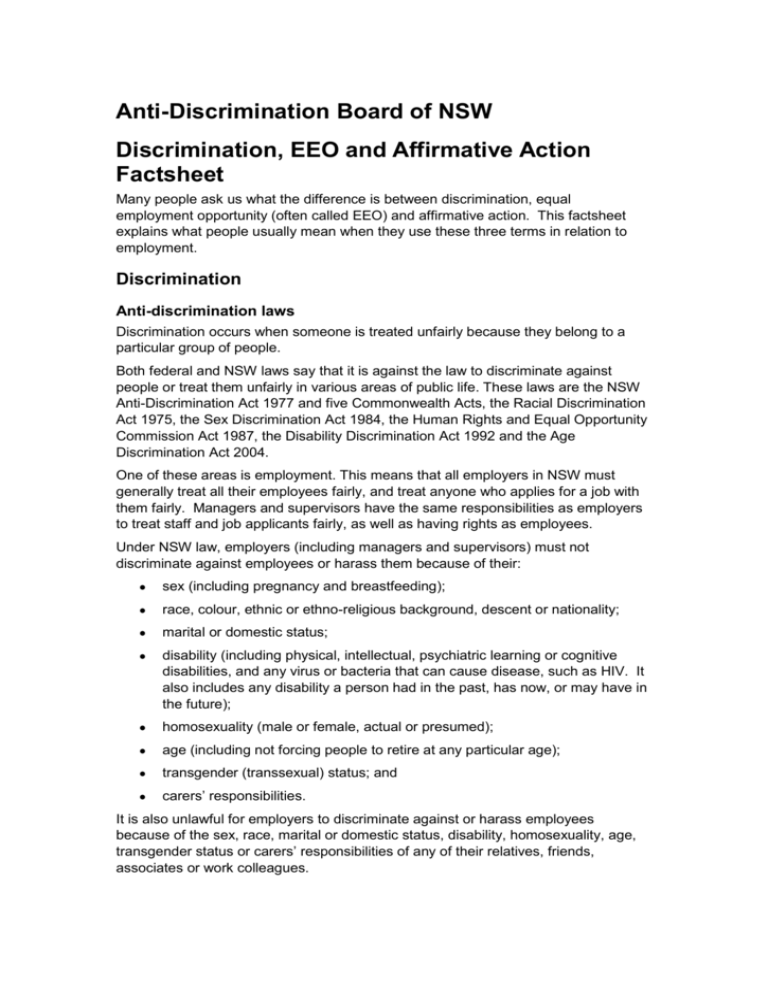Discrimination, EEO and Affirmative Action Factsheet
advertisement

Anti-Discrimination Board of NSW Discrimination, EEO and Affirmative Action Factsheet Many people ask us what the difference is between discrimination, equal employment opportunity (often called EEO) and affirmative action. This factsheet explains what people usually mean when they use these three terms in relation to employment. Discrimination Anti-discrimination laws Discrimination occurs when someone is treated unfairly because they belong to a particular group of people. Both federal and NSW laws say that it is against the law to discriminate against people or treat them unfairly in various areas of public life. These laws are the NSW Anti-Discrimination Act 1977 and five Commonwealth Acts, the Racial Discrimination Act 1975, the Sex Discrimination Act 1984, the Human Rights and Equal Opportunity Commission Act 1987, the Disability Discrimination Act 1992 and the Age Discrimination Act 2004. One of these areas is employment. This means that all employers in NSW must generally treat all their employees fairly, and treat anyone who applies for a job with them fairly. Managers and supervisors have the same responsibilities as employers to treat staff and job applicants fairly, as well as having rights as employees. Under NSW law, employers (including managers and supervisors) must not discriminate against employees or harass them because of their: sex (including pregnancy and breastfeeding); race, colour, ethnic or ethno-religious background, descent or nationality; marital or domestic status; disability (including physical, intellectual, psychiatric learning or cognitive disabilities, and any virus or bacteria that can cause disease, such as HIV. It also includes any disability a person had in the past, has now, or may have in the future); homosexuality (male or female, actual or presumed); age (including not forcing people to retire at any particular age); transgender (transsexual) status; and carers’ responsibilities. It is also unlawful for employers to discriminate against or harass employees because of the sex, race, marital or domestic status, disability, homosexuality, age, transgender status or carers’ responsibilities of any of their relatives, friends, associates or work colleagues. This means that all employees are entitled to equal opportunities, whether they are male or female, from one ethnic group rather than another, married or not, older or younger, and so on. Employers must not allow any prejudices or stereotyped views they have about any groups of people to influence who they hire, how they treat people while they are employed, and who they dismiss or make redundant. For example, an employer might assume that an older person wouldn’t “fit in” with a predominantly young team, or that a woman isn’t worth sending for training because she might get pregnant and leave, or that a person with a disability can’t use a computer, or that a transgender person might make other staff feel uncomfortable. If these assumptions result in the person being treated differently, they could be discriminatory. Indirect discrimination Indirect discrimination is also against the law in NSW. This occurs when there is a rule or requirement that disadvantages one group more than another – unless it can be shown that the particular rule or requirement is ‘reasonable in all the circumstances’. For example, a requirement that people must be over 180cm tall to do a particular job might discriminate against women and some ethnic groups. This is because they are less likely to be this height than men or people from other ethnic groups. It may be discrimination if the job does not really need someone to be 180cm tall, or could be easily be adapted to suit shorter people. Employing people with disabilities To ensure that people with disabilities are given an equal opportunity, antidiscrimination law says that employers must provide any special facilities or services that a person with a disability needs to do a job – unless it would cause the employer ‘unjustifiable hardship’ to do this. For example, a person with limited manual dexterity may not be able to use a standard computer mouse, but they might be able to use an inexpensive trackball attachment. Or a person with a back injury may not be able to stand up to do a counter job, but it may be easy to buy a chair of suitable height so they could do it sitting down. For more information about unjustifiable hardship, contact the Anti-Discrimination Board’s Enquiry Service. Employing people with carers’ responsibilities To ensure that people with carers’ responsibilities are given an equal opportunity, anti-discrimination law says that employers must generally make any reasonable arrangements that a person with carers’ responsibilities needs to do a job – unless it would cause the employer ‘unjustifiable hardship’ to do this. Examples of such arrangements might be to allow the person to work partly from home, adjusting working hours, working part-time or job-sharing, and being flexible about how paid and unpaid leave is used. For more information about unjustifiable hardship, contact the Anti-Discrimination Board’s Enquiry Service. Discriminating in favour of particular groups The anti-discrimination laws allow employers to discriminate in favour of some groups in certain circumstances. Employers can employ people of one sex rather than another, people of particular races or ethnic groups and people of particular ages when it is a genuine occupational qualification for the job to be a certain sex, race or age. For example, it is generally OK to employ a male actor for a male part in a play, or a person under the age of 21 to do a ‘junior’ job, or a woman to clean female toilets, or a person of a particular ethnic group to provide welfare services for that group. In these kinds of cases, employers can go ahead and employ a person of a particular sex, race or age without getting permission from anyone. In other cases, employers need to get a specific exemption from the antidiscrimination laws before they can discriminate in favour of particular groups. Exemptions are generally granted when targeting the job to a particular group will help redress disadvantages that group may have experienced in the past. For example, a local council may apply for an exemption to provide traineeships for Aboriginal and Torres Strait Islander people. This would give training and employment opportunities for a group that has been disadvantaged in these areas, and may also improve links between the council and the local Aboriginal and Torres Strait Islander community. Exemptions are usually only granted where the employer intends to run what is effectively an ‘affirmative action strategy’ – refer to the next page for more about this. For more information about when exemptions are necessary, refer to the Exemption Guidelines on the Anti-Discrimination Board’s website, or contact our Enquiry Service. Equal Employment Opportunity These days, many employers call themselves equal employment opportunity (EEO) employers. They may have an EEO Officer to oversee EEO in their workplace, or they may simply ensure that their human resources manager and other managers understand and follow EEO. Their job advertisements may say that they want people who will follow EEO principles. Employers are likely to mean one of two things when they use the term EEO. The two meanings of EEO are: Sometimes it means that the employer follows the anti-discrimination laws and tries to ensure that everyone in their workplace understands these laws and follows them too. Other times it means that as well as following anti-discrimination laws, the employer implements specific equal employment opportunity management plans or programs designed to ensure that everyone really does have equal opportunity in their workplace. For example, they may keep statistics on the proportions of different groups at different levels in their workplace to help them monitor how EEO is working. They may try to identify and remove any barriers that certain groups face in achieving real equal opportunity. This sort of planning is a more structured and foolproof way of ensuring that the employer does not break the anti-discrimination laws, even unwittingly. The law says that all NSW and Commonwealth public sector organisations (including government departments and authorities, NSW health authorities and hospitals, and NSW universities) and all NSW local councils must prepare EEO plans. Under Part IXA of the NSW Anti-Discrimination Act 1977, the Public Service Reform Act 1984 (Cth), the Employment Opportunity (Commonwealth Authorities) Act 1987 (Cth) and the NSW Local Government Act 1993, respectively. They must pay particular attention to groups that have been disadvantaged in the past. These groups are women, Aboriginal and Torres Strait Islander people, people from non-English speaking backgrounds and people with disabilities. In NSW, these plans are co-ordinated by the NSW Office of the Director of Equal Opportunity in Public Employment. Affirmative action EEO plans often include what many people understand to be ‘affirmative action strategies’. People generally use the term affirmative action in one of three ways: to cover everything to do with equal opportunity plans, as described above. to describe specific affirmative action strategies to help groups that have been disadvantaged in the past, such as special training or recruitment programs for women or Aboriginal and Torres Strait Islander people. Such affirmative action strategies help give previously disadvantaged groups the skills and confidence to compete on equal terms with everyone else. They also help ensure that employers get the best performance out of all employees in their workplace. In order to implement these affirmative action strategies in NSW, employers generally need to get their program certified. For more information about when this is necessary, contact the Anti-Discrimination Board’s Enquiry Service. to cover programs and strategies aimed at women only. The Commonwealth Equal Opportunity for Women in the Workplace Act 1999 says that all employers with 100 or more employees and all higher education institutions must implement an ‘affirmative action program’ to promote equal opportunity for women. They must report on this program annually to the Equal Opportunity for Women in the Workplace Agency, a federal government body. An affirmative action program is a structured approach to addressing any disadvantages that women have experienced, and ensuring that they can compete equally for employment, training and promotion opportunities. An affirmative action program involves keeping statistics on the occupations and employment status of women in the organisation, and using these to redress any imbalance in the profile of the workforce. It also involves implementing specific affirmative action strategies such as training or recruitment programs for women, introducing part-time work for women returning from maternity leave, and reviewing promotion procedures to ensure that all promotions are based solely on merit. For more detailed information on making a complaint and the complaint process refer to our website and select ‘Making a complaint’, or ask for our factsheet on Complaining to the Anti-Discrimination Board. The Anti-Discrimination Board of NSW Enquiries Phone (02) 9268 5544 Toll free number 1800 670 812 (if you are calling from outside Sydney) TTY (02) 9268 5522 Email: adbcontact@agd.nsw.gov.au Complaints Phone (02) 9268 5544 Toll free number 1800 670 812 (if you are calling from outside Sydney) TTY (02) 9268 5522 Email: complaintsadb@agd.nsw.gov.au Telephone interpreter service Phone 13 14 50 Website antidiscrimination.justice.nsw.gov.au Sydney Level 4, 175 Castlereagh Street, Sydney NSW 2000 PO Box A2122, Sydney South NSW 1235 Phone (02) 9268 5555 Fax (02) 9268 5500 TTY (02) 9268 5522 Wollongong 84 Crown Street, Wollongong NSW 2500 PO Box 67, Wollongong NSW 2520 Phone (02) 4267 6200 Fax (02) 4267 6261 TTY (02) 4267 6267 Newcastle Level 3, 97 Scott Street, Newcastle NSW 2300 PO Box 1077, Newcastle NSW 2300 Phone (02) 4903 5300 Fax (02) 4903 5376 TTY (02) 4903 5389 Revised March 2011







